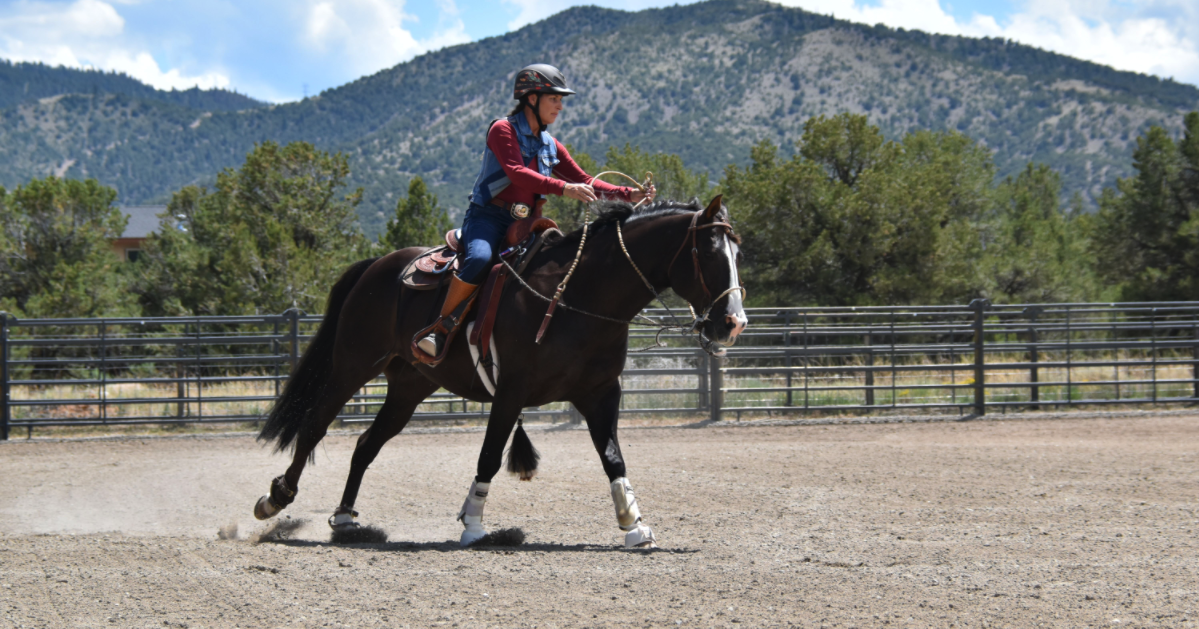How to ask for the canter, with Julie Goodnight
- May 11, 2020
- ⎯ Julie Goodnight

Question:
Help! This horse won’t pick up the canter! How do I ask for the canter correctly and how do I pick up the correct lead?
I am helping a friend train her horse, an 8-year-old Appaloosa gelding she has owned for more than a year. Her horse responds well to my leg cues, but since her stirrup length is at least a foot shorter than mine (I’m much taller than she is), her leg cues touch him at a totally different place. This horse side passes and leg yields for her perfectly, but lately he has been avoiding the canter departure. We’ve already checked for proper saddle fit and bit issues, and otherwise, he seems very willing to work. How can we teach her horse to pick up the canter? Why would he lose his canter depart after learning to leg yield?

Answer:
Canter Cue Confusion
I don’t believe this is a problem with leg placement or stirrup length; I think this is a matter of cue confusion: Your friend has accidentally trained her horse to do the wrong thing. He will probably be easy to retrain—he hasn’t forgotten how to do a canter depart, he just thinks the correct answer to her cue is to leg yield.
The cues for a leg yield and canter are easy to confuse because they are quite similar. I’ve seen many horses make this mistake, and the fact that you have been schooling leg yields makes it even more likely. I’m betting what happened was that your friend inadvertently rewarded the horse when he gave the wrong response to her cue for the canter.
When training, we often use a technique known as negative reinforcement, which in this case means releasing pressure when the horse gives the correct response. For instance, when asking for a walk, you apply leg pressure to his sides. As soon as he moves forward, you take away the pressure, thus rewarding the horse for the correct response. But, if you were to apply leg pressure to move forward and the horse ignored the signal, even if you stopped the pressure only momentarily, you would have trained the horse to ignore that leg cue.
Always remember this: Whatever the horse is doing at the moment you release pressure (either from the leg or rein) is what you just trained him to do. The next time you apply that cue, he will do the same thing he did the last time to get the release. It’s amazing how often this is the root of a problem: A rider hesitates after the horse incorrectly responds to a cue, and in that brief moment of pause the pressure is released. As a result, the horse thinks he did the right thing.
The key to successful training lies in how your friend responds when her horse does not “read” her cue correctly: She needs to take immediate action to correct the response and immediately reapply the cue, then release pressure only when the horse does the right thing.
How to Correctly Ask for the Canter
If I had asked a horse for a canter departure and he began leg yielding instead, I would stop his sideways motion with leg and rein cues. I would bounce my outside leg (if you are leg-yielding left, the horse is bent to the right, so your outside leg is the left leg) on his ribs to say, “No, you cannot move that way,” close the outside rein (move my hand toward his neck), and reach forward to immediately send him on. Then, I would check his gait and, if the canter wasn’t picked up, instantly give him another strong, even exaggerated, cue. Using my voice aid to help the horse (with the kissing sound), I would repeat this process until I got the canter departure on the first request, then let him rest as a reward.
Without question, anytime two or more riders share a single horse, it is more difficult for him to distinguish cues because, no matter how similar two people are, their riding cannot be exactly identical. Luckily, most horses quickly adapt to each rider and learn to distinguish the variations in their signals. But I must add it seems unusual that you and your friend would ride with a full foot of difference between your stirrup lengths. This makes me wonder if one or both of you need to reevaluate your positions. For example, a rider with short legs would want a longer-than-average stirrup length to get more leg on the horse and lower her center of gravity. Adjusting your stirrups might make riding in general much easier and more comfortable.
That said, horses learn very fast, so keep up the training! Sometimes, good communication means being clear when a horse does not give the correct response: If he gives the wrong answer, he must be told he is wrong and to try again.
This article first appeared in EQUUS issue #427.





